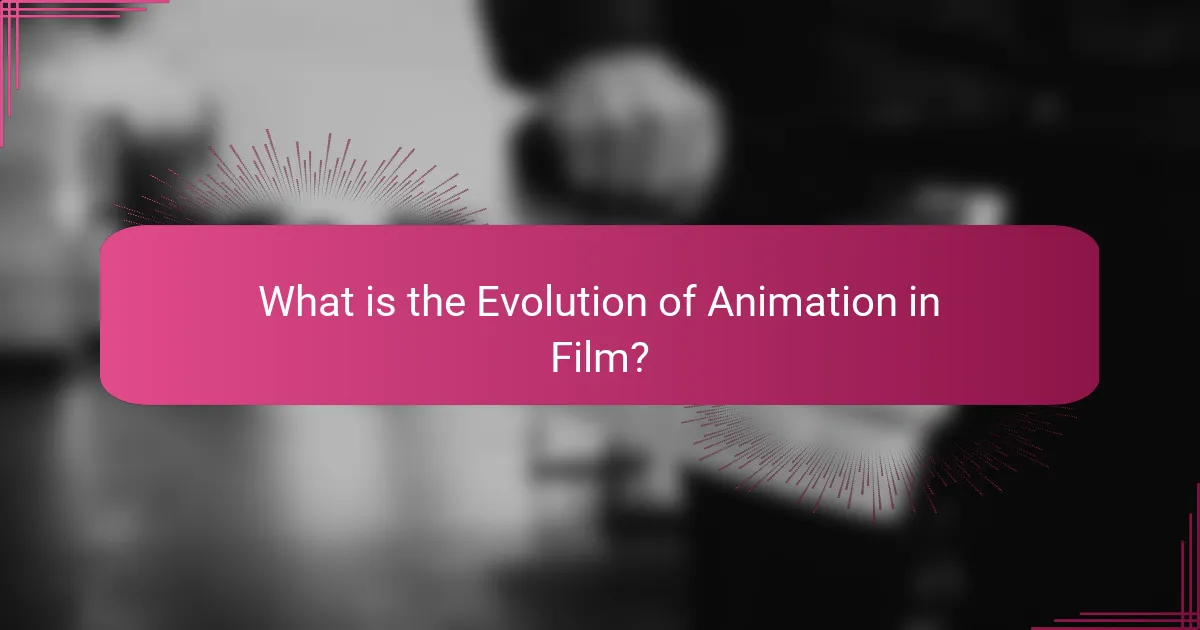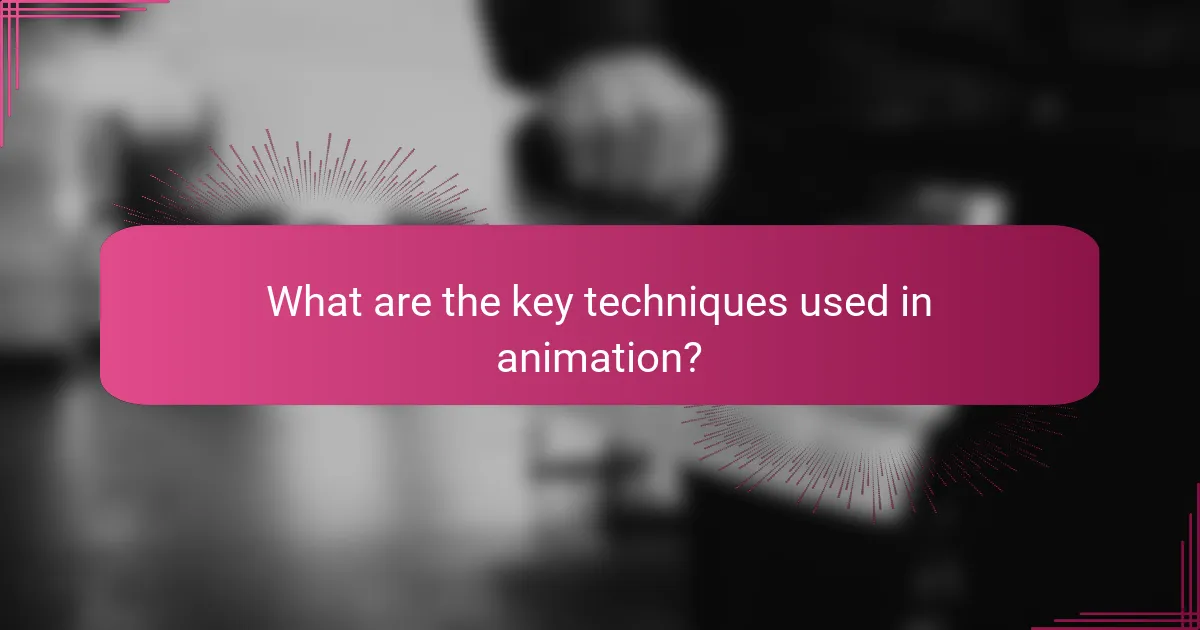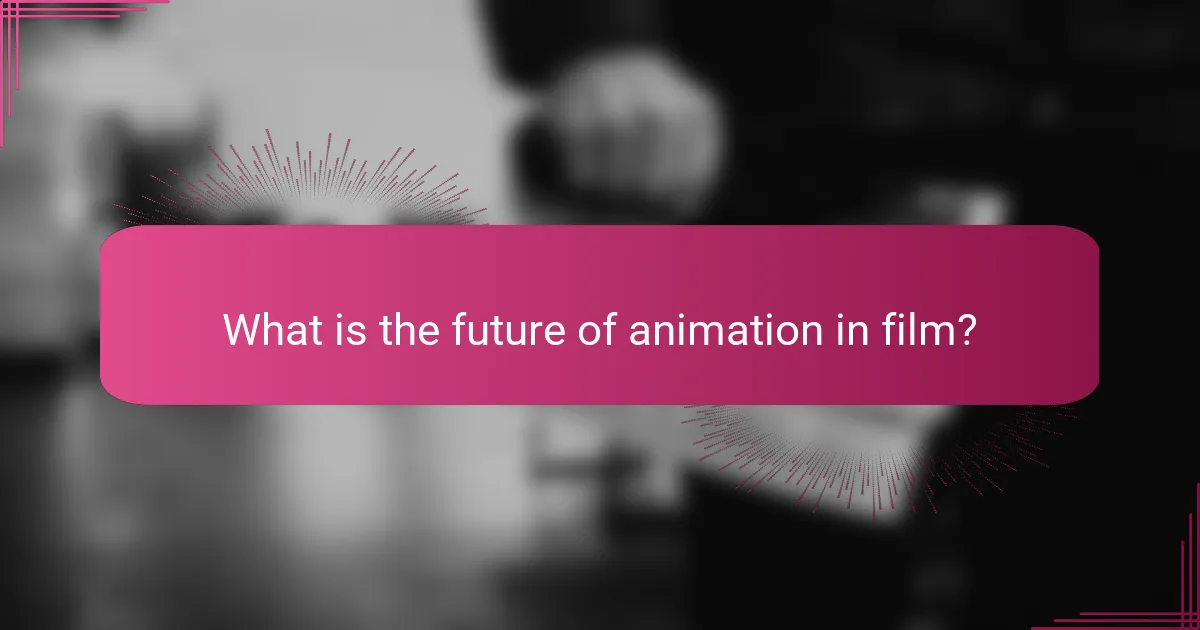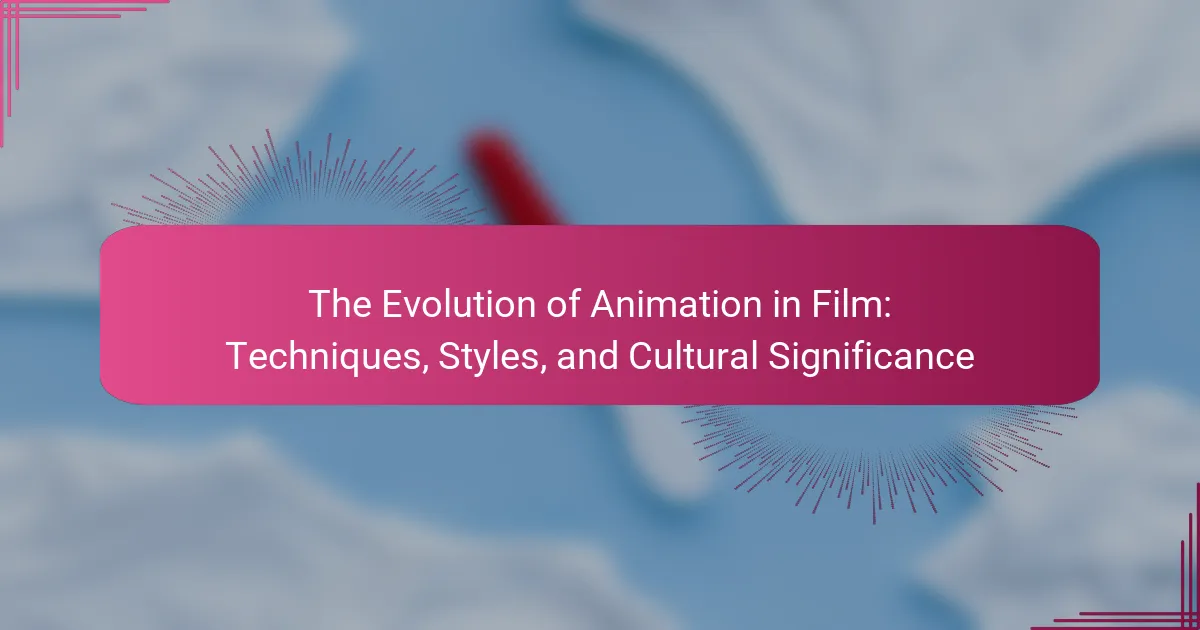The article explores the evolution of animation in film, detailing its key techniques, styles, and cultural significance. It begins with early hand-drawn methods and the invention of devices like the phenakistoscope and zoetrope in the late 19th century, leading to milestones such as Winsor McCay’s “Gertie the Dinosaur” and Walt Disney’s groundbreaking “Snow White and the Seven Dwarfs.” The piece examines traditional hand-drawn animation, stop-motion, and computer-generated imagery (CGI), highlighting their unique applications and historical importance. It also discusses the future of animation, emphasizing the impact of emerging technologies like artificial intelligence and virtual reality, as well as the growing demand for diverse narratives and hybrid formats within the industry.

What is the Evolution of Animation in Film?
The evolution of animation in film began with early hand-drawn techniques. In the late 19th century, inventions like the phenakistoscope and zoetrope showcased moving images. The first animated short, “Gertie the Dinosaur,” was created by Winsor McCay in 1914, marking a significant milestone. The introduction of synchronized sound in the 1920s allowed for more dynamic storytelling. Walt Disney’s “Snow White and the Seven Dwarfs,” released in 1937, was the first full-length animated feature film. This film set the standard for animation quality and narrative depth. The 1960s saw the rise of television animation with shows like “The Flintstones.” In the 1990s, computer-generated imagery (CGI) transformed animation, exemplified by Pixar’s “Toy Story.” Today, animation encompasses various styles and techniques, including 2D, 3D, and stop-motion, reflecting its diverse cultural significance.
How has animation technology changed over the decades?
Animation technology has evolved significantly over the decades. In the early 1900s, animation was primarily hand-drawn and frame-by-frame. This method was labor-intensive and time-consuming. The introduction of cel animation in the 1910s allowed for the reuse of backgrounds, streamlining production. The 1930s saw the advent of synchronized sound in animated films, as exemplified by Disney’s “Steamboat Willie.” The 1950s brought television animation, expanding the medium’s reach. By the 1990s, computer-generated imagery (CGI) revolutionized animation, allowing for more complex and realistic visuals. Today, advancements in 3D animation and virtual reality continue to push the boundaries of the medium. Each decade has introduced new tools and techniques, shaping the art of animation in profound ways.
What were the key innovations in early animation techniques?
Key innovations in early animation techniques include the use of the phenakistoscope and the zoetrope. The phenakistoscope, developed in 1832 by Joseph Plateau, created the illusion of motion through a spinning disc with sequential images. The zoetrope, invented by William George Horner in 1834, allowed for a similar effect using a cylindrical device with slits that displayed images in rapid succession. Another significant innovation was the introduction of stop-motion animation, which involved photographing objects in incremental movements. This technique gained popularity in the late 19th century with works like “The Humpty Dumpty Circus” (1898) by J. Stuart Blackton. Additionally, the development of cel animation in the early 20th century, notably by Earl Hurd, enabled the use of transparent sheets for characters, streamlining the animation process. These innovations laid the foundation for modern animation techniques, influencing filmmakers and animators for generations.
How did the introduction of digital technology transform animation?
The introduction of digital technology transformed animation by enabling faster production and greater creative possibilities. Traditional animation required labor-intensive hand-drawn techniques. Digital tools streamlined these processes, allowing animators to work more efficiently. Software like Adobe Animate and Autodesk Maya revolutionized animation techniques. These tools facilitated 2D and 3D animation, increasing visual complexity. Digital technology also introduced CGI, enhancing realism in animated films. A notable example is Pixar’s “Toy Story,” the first fully computer-animated feature film released in 1995. This shift expanded the animation industry’s scope, attracting broader audiences and fostering innovation.
What are the major styles of animation in film?
The major styles of animation in film include traditional animation, 3D animation, stop-motion animation, and computer-generated imagery (CGI). Traditional animation involves hand-drawn frames, creating a fluid motion through a series of images. This style was prevalent from the early 20th century until the rise of digital technologies. 3D animation utilizes computer software to create three-dimensional models and environments. This style gained prominence in the 1990s, with films like “Toy Story” showcasing its capabilities. Stop-motion animation involves photographing physical objects in small increments to create the illusion of movement. This technique has been used in films like “The Nightmare Before Christmas.” CGI combines computer graphics with live-action footage, allowing for complex visual effects and animated characters in films like “Avatar.” Each style has contributed uniquely to the evolution of animation in film.
How do traditional animation styles differ from modern techniques?
Traditional animation styles primarily involve hand-drawn techniques, while modern techniques often utilize digital tools. Traditional animation requires frame-by-frame drawing, typically on paper or cels. This method can be labor-intensive and time-consuming. In contrast, modern animation allows for computer-generated imagery (CGI), which streamlines the process. CGI enables animators to create three-dimensional characters and environments more efficiently. Traditional styles often emphasize a unique artistic flair, while modern techniques prioritize realism and detail. The shift to digital has also expanded the range of visual effects and animation possibilities. Historical examples include Disney’s “Snow White” as a traditional work, compared to Pixar’s “Toy Story,” which showcases modern techniques.
What are the characteristics of stop-motion animation?
Stop-motion animation is characterized by its frame-by-frame technique. This method involves capturing still images of physical objects. The objects are moved slightly between each shot. When played in sequence, these images create the illusion of movement.
Common characteristics include the use of puppets or models. These can be made from various materials like clay, wood, or fabric. Stop-motion often features a distinct visual style. It can convey a tactile, handcrafted feel that sets it apart from digital animation.
Additionally, the process requires meticulous planning and patience. Animators must consider timing and movement for each frame. Historical examples include films like “The Nightmare Before Christmas.” This film showcases the unique charm of stop-motion animation.
Why is cultural significance important in animation?
Cultural significance is important in animation because it shapes storytelling and audience connection. Animation reflects cultural values, beliefs, and social issues. This medium allows for diverse representation and fosters understanding among different cultures. For instance, films like “Coco” highlight Mexican traditions, promoting cultural appreciation. Additionally, animation can challenge stereotypes and provide new perspectives. By integrating cultural elements, animators create relatable characters and narratives. This engagement enhances emotional resonance with viewers. Ultimately, cultural significance enriches the animation landscape and influences its evolution.
How does animation reflect societal values and issues?
Animation reflects societal values and issues by portraying cultural narratives and social commentary. It serves as a mirror to contemporary societal norms and challenges. For example, animated films like “Zootopia” address themes of prejudice and discrimination. Similarly, “Wall-E” critiques consumerism and environmental neglect. Historical context shows that animations often respond to political climates, such as wartime propaganda in the early 20th century. The evolution of animation styles also reflects changing attitudes, with more diverse characters emerging in recent years. This progression highlights a growing recognition of inclusivity and representation in society. In summary, animation not only entertains but also engages with and influences societal values and issues.
What role does animation play in cultural storytelling?
Animation serves as a powerful medium for cultural storytelling. It allows for the expression of complex narratives and cultural themes. Through visual art, animation captures the essence of traditions and beliefs. It transcends language barriers, making stories accessible to diverse audiences. For instance, Studio Ghibli films incorporate Japanese folklore, enriching global understanding of cultural nuances. Animation can also reflect societal issues and historical events, fostering empathy and awareness. Its unique ability to blend imagination with reality creates engaging narratives that resonate across generations. Thus, animation plays a crucial role in preserving and promoting cultural heritage.

What are the key techniques used in animation?
The key techniques used in animation include traditional hand-drawn animation, stop-motion animation, and computer-generated imagery (CGI). Traditional hand-drawn animation involves creating frames by drawing images on paper, which gives a classic aesthetic. Stop-motion animation utilizes physical models or puppets that are photographed in incremental movements to create the illusion of motion. CGI employs computer software to generate animated sequences, allowing for intricate details and lifelike effects. Each technique has its unique applications and historical significance in the evolution of animation. For instance, traditional animation was predominant in early films, while CGI has transformed modern storytelling in cinema.
How do different animation techniques impact storytelling?
Different animation techniques significantly impact storytelling by influencing visual style, pacing, and emotional engagement. Techniques such as traditional hand-drawn animation create a unique aesthetic that can evoke nostalgia. For example, Disney’s classic films often utilize this technique, enhancing emotional depth through fluid character movements.
In contrast, 3D animation allows for more realistic portrayals and dynamic camera angles, as seen in Pixar films. This technique enhances immersion and audience connection to characters. Stop-motion animation, like that used in “Coraline,” provides a tactile quality that can add to the story’s atmosphere.
Each technique shapes narrative delivery. For instance, fast-paced animation can create urgency, while slower techniques allow for reflection. The choice of animation style directly affects how audiences perceive and relate to the story. Thus, the animation technique used is crucial in shaping the overall storytelling experience.
What are the advantages of 2D animation compared to 3D animation?
2D animation has several advantages over 3D animation. It is generally more cost-effective to produce. The production time for 2D animation is often shorter. This allows for quicker project turnaround. Additionally, 2D animation offers a unique aesthetic appeal. It can convey emotions and styles that resonate with specific audiences. 2D animation is often easier for beginners to learn. This accessibility can foster creativity and innovation in storytelling. Furthermore, 2D animation can be more versatile in certain artistic contexts. Classic examples include hand-drawn animations that evoke nostalgia. These factors contribute to the ongoing popularity of 2D animation in various media.
How does motion capture enhance animated films?
Motion capture enhances animated films by providing realistic movements and expressions. It captures the actor’s physical performance in real-time. This technology translates live-action movements into animated characters. The result is more lifelike animations that resonate with audiences. For instance, films like “Avatar” and “The Lion King” utilize motion capture for enhanced realism. Studies show that audiences respond better to animated characters with human-like movements. This technique bridges the gap between animation and reality, enriching storytelling. Overall, motion capture elevates the emotional depth and authenticity of animated films.
What are some innovative animation techniques currently being explored?
Innovative animation techniques currently being explored include virtual reality (VR) animation, which immerses viewers in a 3D environment. This technique allows for interactive storytelling, enhancing audience engagement. Another technique is augmented reality (AR) animation, which overlays digital elements onto the real world. AR creates a blend of physical and digital experiences. Additionally, machine learning is being utilized to automate animation processes. This technology can analyze existing animations to generate new content efficiently. Stop-motion animation is also seeing a resurgence, with filmmakers using advanced materials and techniques to create more lifelike movements. Furthermore, 2D animation is being combined with 3D elements for a hybrid approach. This technique provides depth while maintaining a traditional aesthetic. These innovations reflect a growing trend toward integrating technology with artistic expression in animation.
How is virtual reality influencing the future of animation?
Virtual reality is transforming the future of animation by creating immersive experiences. It allows animators to develop interactive environments that engage users in new ways. This technology enhances storytelling by enabling viewers to become part of the narrative. VR also facilitates real-time rendering, which streamlines the animation process. Animators can visualize scenes in three dimensions, improving spatial awareness and design accuracy. The integration of VR in animation is evident in projects like “The Lion King” remake, which utilized virtual production techniques. As VR technology advances, it is likely to become a standard tool in animation studios. This shift will redefine audience engagement and creative possibilities in the animation industry.
What role does artificial intelligence play in modern animation?
Artificial intelligence significantly enhances modern animation by automating processes and improving efficiency. AI algorithms can generate realistic character movements and [censured] expressions. This technology allows animators to focus on creativity rather than repetitive tasks. For instance, AI can assist in creating in-between frames, reducing the time needed for frame-by-frame animation. Companies like Pixar and Disney use AI to streamline workflows and enhance visual quality. Additionally, AI tools can analyze audience reactions, helping creators tailor content to viewer preferences. The integration of AI in animation thus transforms traditional practices and opens new creative possibilities.

What is the future of animation in film?
The future of animation in film is poised for significant growth and innovation. Advances in technology, such as artificial intelligence and virtual reality, will enhance animation techniques. These technologies will allow for more immersive storytelling experiences. Furthermore, the demand for diverse content will drive the exploration of unique styles and narratives. Animation will increasingly integrate with live-action films, creating hybrid formats. Global collaboration will expand the reach of animated films across cultures. Streaming platforms will continue to provide new opportunities for animated content. As a result, animation will become a dominant form of storytelling in cinema.
What trends are emerging in the animation industry?
Emerging trends in the animation industry include the rise of virtual reality (VR) and augmented reality (AR) experiences. These technologies allow for immersive storytelling and interactivity. Additionally, there is a growing emphasis on diversity and representation in animated content. Productions are increasingly showcasing varied cultural narratives and characters. Another trend is the use of artificial intelligence (AI) in animation production. AI tools streamline processes like character design and animation rendering. Sustainable practices are also gaining traction, with studios focusing on environmentally friendly production methods. Finally, the popularity of streaming platforms has shifted the focus toward shorter, episodic animated series. This trend reflects changing viewer preferences for bite-sized content.
How are global influences shaping the future of animation?
Global influences are significantly shaping the future of animation. Diverse cultural narratives are being integrated into mainstream animation. This blend creates richer storytelling and broader audience appeal. Technological advancements are also facilitating global collaboration. Artists from different countries can now work together seamlessly. Streaming platforms are promoting international content, increasing accessibility. This exposure encourages cross-cultural exchange and innovation. The rise of global animation festivals showcases diverse styles and techniques. These influences are driving the evolution of animation towards a more inclusive and varied landscape.
What skills will animators need to adapt to future changes?
Animators will need advanced technical skills to adapt to future changes. Proficiency in 3D modeling software is essential as the industry shifts towards more immersive experiences. Understanding artificial intelligence tools will become increasingly important for streamlining workflows. Collaboration skills will be necessary for working in diverse teams across various platforms. Knowledge of virtual and augmented reality will enhance storytelling capabilities. Familiarity with data visualization techniques will help in creating engaging content. Continuous learning will be crucial to keep pace with evolving technologies. Adaptability to new animation styles and trends will ensure relevance in a competitive market.
What practical tips can enhance animation skills?
Practice regularly to enhance animation skills. Consistent practice helps develop muscle memory and understanding of movement. Study the principles of animation, such as timing and spacing. These principles are foundational for creating believable motion. Analyze existing animations to understand techniques used by professionals. Break down scenes frame by frame to see how they achieve effects. Utilize software tools effectively to streamline the animation process. Familiarity with tools like Adobe Animate or Blender can significantly improve efficiency. Seek feedback from peers or mentors to identify areas for improvement. Constructive criticism can lead to valuable insights and growth. Attend workshops or online courses to learn new techniques and trends. Continuous learning is crucial in the evolving field of animation.
How can aspiring animators develop their unique style?
Aspiring animators can develop their unique style by exploring diverse artistic influences. They should study various animation techniques and genres to understand different styles. Practicing regularly enhances their skills and helps refine their personal aesthetic. Creating a portfolio showcasing their work allows them to identify patterns in their style. Seeking feedback from peers and mentors provides valuable insights for improvement. Engaging with the animation community fosters inspiration and collaboration. Consistently experimenting with new tools and methods keeps their style evolving. This approach is supported by the fact that many successful animators, like Hayao Miyazaki, have drawn inspiration from a wide range of sources.
What resources are available for learning animation techniques?
Online courses are available for learning animation techniques. Platforms like Coursera, Udemy, and Skillshare offer structured courses. These courses cover various animation styles and software. Books such as “The Animator’s Survival Kit” provide in-depth knowledge. YouTube hosts numerous tutorials from experienced animators. Forums and communities, like Animation Mentor and DeviantArt, allow for peer feedback. Software documentation, such as Adobe Animate and Blender manuals, serves as valuable resources. All these resources support diverse learning preferences and skill levels.
The main entity of the article is the evolution of animation in film, encompassing its techniques, styles, and cultural significance. The article outlines the historical progression of animation, starting from early hand-drawn methods to the introduction of digital technology and CGI. Key innovations, such as stop-motion and motion capture, are discussed alongside the impact of animation on storytelling and cultural representation. Emerging trends, including VR and AI integration, are highlighted as shaping the future of the animation industry, emphasizing the need for animators to adapt their skills to these changes.
